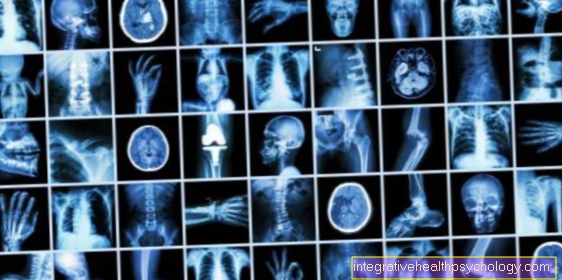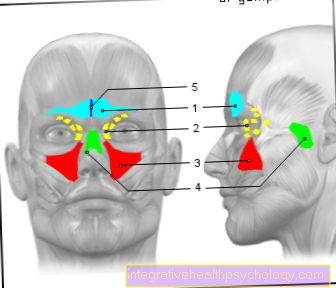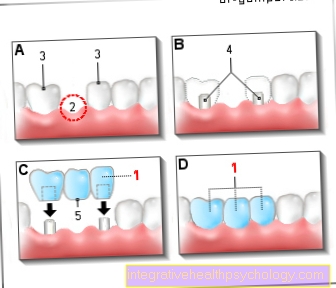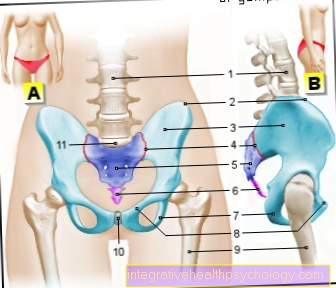MRI - How far do I have to put my head in?
introduction
In magnetic resonance tomography (MRT), imaging is carried out with the help of a strong magnetic field. To do this, the patient is pushed into a closed tube with a diameter of 50 to 60 cm, lying on a table. Depending on the question, different parts of the body can be inside the tube, while others are outside. Especially when examining the upper body (head, neck / thoracic spine, shoulder, heart, lungs), the head is often inside the tube.
Especially in patients with claustrophobia (claustrophobia) this represents a serious problem. For this reason, new MRT devices have been developed in the last few decades, which can be used if necessary. In addition to a wider diameter (up to 70 cm), these devices are significantly shorter, which is why there are only a few body sections inside the tube apart from the body region to be examined. In addition, so-called open MRI devices have been developed. The magnetic field is generated by a C-shaped magnet that is open on one side. The patient has a 320 ° view during the examination. However, the examination in an open MRI is not possible for all questions and is only partially paid for by the health insurance companies.
Read about this too MRI for claustrophobia

MRI on the head
When examining the head in a closed MRI tube, it is located inside the tube. You are pushed into the tube headfirst on a table. The patient sees only the inside of the tube during the imaging and is not allowed to move during the period of the examination. In addition, the head is additionally fixed with a kind of grid (coil).
If the patient is known to be claustrophobic, he or she should inform the doctor in advance. Frequently questionnaires are filled out before the examination, in which the claustrophobia can be noted. The doctor may then give the patient a sedative (Dormicum) administer. In rare cases, brief anesthesia with propofol may also be indicated. In addition, the patient receives a button with which he can abort the examination at any time.
Read more about this under
- MRI of the head
- Dormicum
- Propofol
MRI of the cervical spine
When examining the cervical spine (Cervical spine), the head is usually also inside the closed MRI tube. Depending on the device, however, it may be possible that the head is located in the vicinity of the opening of the tube and the patient can at least partially look out of the MRT device. The patient is pushed into the tube head first.
In order to ensure good image quality, the head and shoulders are fixed during the examination of the cervical spine. The administration of a sedative (Dormicum) or a short anesthetic Propofol is also possible.
Read more about this under MRI of the cervical spine
MRI of the shoulder
The position of the head for an MRI scan of the shoulder is comparable to that for imaging the cervical spine. The head is usually located near the opening of the tube. The patient is also pushed head first into the tube. The shoulder is fixed for the examination and surrounded by a kind of grid (coil) that receives the image information. The administration of a sedative is also possible if necessary.
Read also on this topic MRI of the shoulder joint
MRI of the hand
Various options are available for an MRI examination of the hand. Different examinations are preferred depending on the existing equipment of a clinic or practice. In any case, the hand is fixed and a coil is placed around the hand.
When examining the hand in a closed MRI machine (tube), the patient is pushed into the tube with an outstretched and fixed arm. The patient's head and upper body are usually still outside the tube. In addition, the examination of the hand is also possible with newly developed devices in which the patient in a sitting position stretches the corresponding joint into a magnetic field to be examined.
Read more about this under MRI of the hand
MRI of the heart and lungs
For an MRI scan of the heart and lungs, the patient is also pushed head first into the MRI tube. In the case of tubes that are open on both sides, the head is usually located approximately at the edge of the tube (usually still within the tube). With the newer short MRT machines, the patient can sometimes look out of the tube.
The patient must not move during the examination in order to ensure good image quality. If necessary, a sedative (Dormicum) can be administered. A short anesthetic may also be indicated if you are known to be claustrophobic.
Read more about this under
- MRI of the heart
- MRI of the lungs
MRI of the thoracic spine
To examine the thoracic spine (thoracic spine), the patient is placed in the MRI tube in roughly the same way as for imaging the heart and lungs. The patient is pushed into the tube head first. During the examination, this is located approximately at the edge of the tube, which is open on both sides. Depending on the device, the patient can sometimes look out of the tube.
As with all other MRI exams, a sedative may be given prior to the imaging. During the examination, the patient also receives a button with which he can stop the examination at any time if he or she feels unwell.
Read more about this under MRI of the thoracic spine
MRI of the abdomen
When examining the abdomen in the MRI, the patient is also pushed head first into the tube. However, the head is often already outside the tube, which is open on both sides. However, the position of the head can differ significantly depending on the device. Especially with the newer, shorter MRI tubes, the patient can look out of the tube during the examination. This makes it easier to examine the abdomen in patients with known claustrophobia (claustrophobia).
Read also on this topic
- MRI of the abdomen
- MRI of the abdominal organs
MRI of the lumbar spine
The position of the head in MRI imaging of the lumbar spine (lumbar spine) is comparable to that in the examination of the abdomen or the pelvis or the hip. The head is located approximately at the edge of the tube, which is open on both sides. Especially with the smaller MRT machines developed in recent years, the patient can often look out of the tube during the examination. Nonetheless, it is possible for the attending physician to administer a sedative prior to imaging.
Read more about this under MRI of the lumbar spine
MRI of the pelvis and hip
During the MRI examination of the pelvis or hip, the patient is also pushed head first into the MRT tube, which is open on both sides. The position of the head is comparable to that when examining the lumbar spine or the abdomen. The head is located outside the tube, especially during examinations in newer MRI machines. In the case of known claustrophobia, it is still possible to administer a sedative (Dormicum).
Read more about this under
- MRI of the pelvis
- MRI of the hip
MRI of the knee
There are several options available for examining the knee with magnetic resonance imaging. On the one hand, imaging can take place in the MRT tubes that are open on both sides. For this, the patient is only pushed into the tube up to the stomach or up to the upper body. In either case, the patient's head is outside the tube. There is no fear of claustrophobia during the examination.
On the other hand, in recent years new devices have been developed in which the various joints (including the knee joint) can be examined in a sitting position. The joint to be examined is stretched in a weaker magnetic field.
Read more about this under MRI of the knee
MRI of the foot / ankle
As with the MRI examination of the knee, different options are available for the examination of the foot or ankle. However, the upper body and head are always outside the tube, regardless of the MRI machine. The MRI examination of the foot / ankle is therefore not a problem for patients with diagnosed claustrophobia.
To examine the foot / ankle joint, the patient is only driven into a closed MRI tube with the foot. Imaging of the foot in a sitting position with the newly developed MRI devices is also possible. The foot is stretched in a smaller magnetic field.
Read about this too
- MRI of the foot
- MRI of the ankle





























